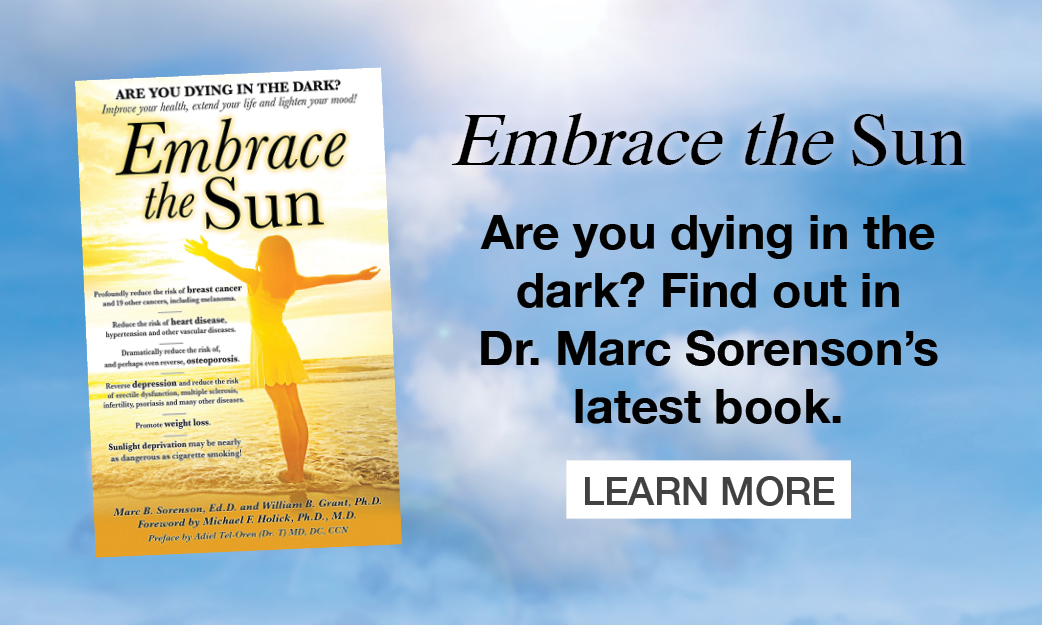Healthful Sun Use
How to safely enjoy the sun:
1. Never burn and never expose yourself until the skin reddens. If you do not tan, reddening may occur in a very few minutes. Cover up or seek shade immediately at the first sign of pinkness.
2. If you begin your sunning program during summer, be sure to start with only a few minutes and gradually work up to more time as your skin adjusts.
3. Whenever your skin feels uncomfortably hot, seek shade or cover up. Remember that on a cool spring day, you may burn before you feel uncomfortable. Reddening means you have had too much exposure.
4. Once tanned, you may enjoy the sun until you feel uncomfortable or until you begin to redden over the tan.
5. Even dark-skinned people must be careful to gradually increase sunlight-exposure times.
6. Though you often hear the advice to sunbathe only before 10:00 AM and after 2:00 PM during summer and to avoid the midday sun, it may be best for some most people to expose most of the body to sunlight for a short time at midday. The ratio of UVA to UVB is much higher in mornings and afternoons than at midday, meaning that the sun is more likely to produce UVA-induced melanoma before 10:00 AM and after 2:00 PM.
It also requires 50% more time to produce a given quantity of vitamin D two hours before or after midday than at midday.[1] A short period (20-40 minutes for light-skinned persons) will produce all the vitamin D that the body can make in one day. If one relies on haphazard exposure of the face, hands, and arms only, insufficient skin is exposed to produce enough vitamin D for immediate health benefits and for future storage. In addition, staying long enough to receive the health-producing dose by exposure only of the face, arms and hands may cause overexposure and burning on those areas. Sunbathing at midday (perhaps during a lunch break) makes sense for those who have limited time and has been recommended by Dr. Ann Webb of England as the most efficient method of producing vitamin D.1 For people who have type-1 skin—very light skin that does not tan—vitamin D can be produced at midday by sitting in the shade outside and thereby avoiding direct ultraviolet radiation.[2] There is sufficient UVB light reflected by surrounding objects to stimulate some vitamin D production. The key, at any time of day or for any skin type, is to avoid burning.
7. Consider that sunscreens may cause you to overexpose your skin to UVA light and thus make you more susceptible to melanoma.
8. Remember that it is neither prudent nor healthful to bake yourself in the direct summer sun for hours on end. Different seasons allow for more or less sunlight exposure, and the darker your skin, the more time you can spend in sunlight.
9. It is important to eat a diet low in fat, particularly processed polyunsaturated fatty acids (PUFA). It is also advisable to consume a large quantity of green vegetables as well as colorful fruits to increase carotenoid antioxidants in the skin. I try to eat one-half pound of dark green vegetables per day and a pound of fresh, colorful fruit such as oranges, cherries, blueberries, marionberries and raspberries.
I try to eat at least two tomatoes daily and use some tomato sauce on my low-fat dishes. By consuming forty grams of tomato paste daily for ten weeks, you can increase sunburn-resistance time by 40%.[3] Eating other tomato-based products has also been shown to significantly reduce sunburn,[4] and topically applied lycopene (a powerful antioxidant found in tomatoes) is also effective in preventing skin damage by UV.[5]
[1] Webb, A et al. Calculated ultraviolet exposure for a healthy vitamin D status. Photochem Photobiol 2006;82:1697-1703.
[2] Turnbull, D. Midday shade boosts vitamin D. University of Southern Queensland press release Friday, December 14, 2007.
[3] Stahl, W. et al. Dietary Tomato Paste Protects against Ultraviolet Light–Induced Erythema in Humans. J Nutr 2001;131:1449-51.
[4] Aust, O. et al. Supplementation with tomato-based products increases lycopene, phytofluene, and phytoene levels in human serum and protects against UV-light-induced erythema. Int J Vitam Nutr Res 2005;75:54-60.
[5] Fazekas Z, et al., Protective effects of lycopene against ultraviolet B-induced photodamage. Nutr Cancer 2003;47(2):181-7.
- Protect your Skin! More on Nutrition and Sun Exposure. September 24, 2021
- Outdoor activity, Cardiovascular Disease (CVD) and Vitamin D. Is Sun Exposure the real Key for Protection? September 16, 2021
- Another Benefit of moderate, non burning Sun Exposure: any Damage is quickly repaired. September 9, 2021

